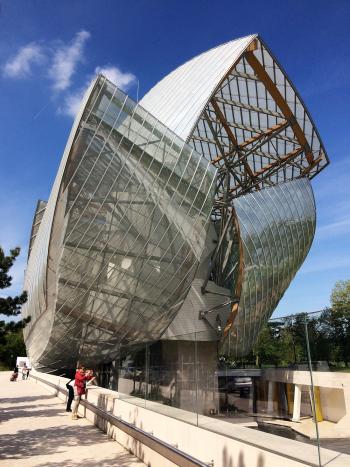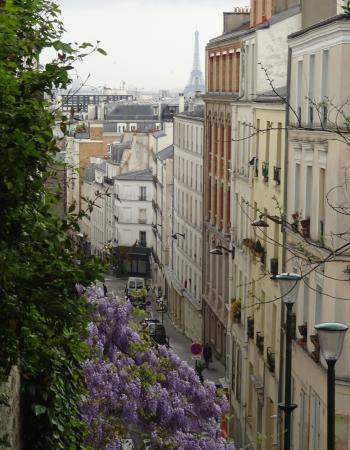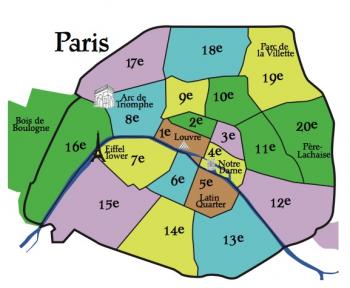Venturing around the arrondissements of Paris
This article appears on page 6 of the August 2018 issue.
On my seventh trip to Paris with friends in April 2018, I realized that I seldom ventured outside the central core of the city, always sticking close to the Seine. In fact, I can recall only one time, on my last trip to Paris, 10 years ago, when I made a worthwhile journey to Père-Lachaise Cemetery in the 20th Arrondissement, aided by the self-tour itinerary in Rick Steves’ Paris guidebook.
City layout
Paris is divided into 20 districts, or arrondissements, numbered in a clockwise spiral. Most visitors are familiar with the 1st through 7th arrondissements. The first four, on the Right Bank, encompass the Marais, Centre Pompidou and the Louvre, while the next three, on the Left Bank, include the Latin Quarter and the Eiffel Tower.
To help wean myself from the central neighborhoods, I convinced my travel companions to take an apartment on Rue du Caire, on the outskirts of the 2nd Arrondissement, the wholesale clothing center of Paris. A 15-minute walk from the Seine, this area had few tourists wandering around, but within blocks was the very lively Rue Montorgueil and Faubourg St. Denis. (Streets beginning with Faubourg indicate that they were outside the 14th-century walls of Paris.)
At the corner of Rue St. Denis and Boulevard St. Denis, one block from our apartment, sat a triumphal arch, marking the spot of the 14th-century entry through that part of the city wall.
On the other side of the gate was the entrance to the 10th Arrondissement, whose personality changes by the hour. I excitedly returned from my first trip up the street to tell my roommates that Nigeria could be found just a block away, but by the time we made our way there a few hours later, it had turned into hipster Paris, and the French Africans had gone home or moved on to other streets. (A warning to the timid — the last few blocks of Rue St. Denis, before the Boulevard, feature older streetwalkers at almost all times of day.)
Venturing out
My first foray outside the central core was a visit to the new Fondation Louis-Vuitton, located in the Bois de Boulogne, a large public park in the 16th Arrondissement. One of my travel companions asked why we didn’t take an Uber to the museum, but the Paris Métro is one of the best underground transport systems I’ve experienced. Trains arrive every five minutes, and so quietly that we almost missed a connection while we perused a map as the train pulled in behind us.
Our visit to the Fondation highlighted the importance of double-checking opening hours. When I did my research for the trip a few months earlier, the museum was open daily. However, when we arrived in April, it was closed on Tuesdays, which was, naturally, the day we chose to visit. Still, it was worth the 20-minute trip from the city center to see the outside of the latest Frank Gehry-designed museum and walk around the large public park on a quiet spring day.
The museum is a 15-minute walk from the nearest Métro stop, and there is good signage along the route.
My second trip outside the inner neighborhoods was to the far side of Place de la République, to the Faubourg du Temple neighborhood in the 11th Arrondissement and Belleville in the 20th.
Faubourg du Temple extends east from Place de la République and continues past Boulevard de la Villette, where the street changes its name to Rue de Belleville. This lively street reminded me of parts of Queens, New York, and represents the melting pot of Paris. French-Arabic and African shops and restaurants gave way to Asian restaurants and more Arabic shops, with a smattering of Russian and other ethnic groups represented.
When the street becomes Belleville, it starts to climb. A right turn on Rue Piat will take you to Parc de Belleville, with one of the best panoramic views of Paris. Pass the first entrance to the park, a few hundred yards from Rue de Belleville, and continue on to the terrace farther on where the road veers left. From there, you can see the Panthéon, Notre-Dame and Montparnasse Tower.
If you return to Rue de Belleville, depending on the time of day and your hunger level, there is a little café one block farther up the street on Rue des Pyrénées or you can choose from the dozens of ethnic restaurants on the street. I stopped at both the café for coffee and a little hole-in-the-wall Arabic restaurant for a great plate of falafel.
More exploring
My third trip to the outlying neighborhoods returned me to Faubourg du Temple, but this time I took a left at Boulevard Jules-Ferry/Quai de Valmy for a lovely walk up Canal Saint-Martin. Midway down the first block is a Picard shop specializing in frozen food. If you’ve never visited one, it’s worth a stop to price frozen foie gras and peruse the variety of prepared frozen foods.
The canal was built during Napoleon’s time to bring fresh drinking water from the Ourcq river. While the canal continues for miles outside of Paris, the distance it covers between Faubourg du Temple and Boulevard de la Villette includes many interesting shops and the lovely Villemin Garden, and you may get to watch one of the canal tour boats negotiate the 2-step lock at Rue de Lancry.
Crossing Boulevard de la Villette, you can continue past the Bassin de la Villette, Paris’ largest artificial lake, to the City of Science and Industry complex in Parc de la Villette. There are Métro stops a few blocks away on both sides of the canal all along its length, so it’s an easy return to your starting point.
My final trip took me past Place de la Bastille, where I found the Coulée verte René-Dumont, the “green course.” This 4.7-kilometer elevated park was built on an obsolete railroad track and was the inspiration for New York City’s High Line Park.
It begins at Avenue Daumesnil right before Rue Moreau, but it has many stairway entries along Daumesnil. It is a narrow, green oasis where local people stroll and jog, and I hope to return soon and complete the entire length, as far as the Périphérique.
My exploration of the neighborhoods of Paris has only whetted my appetite for more. I highly recommend that you make time for at least one visit to the city’s outer neighborhoods.



